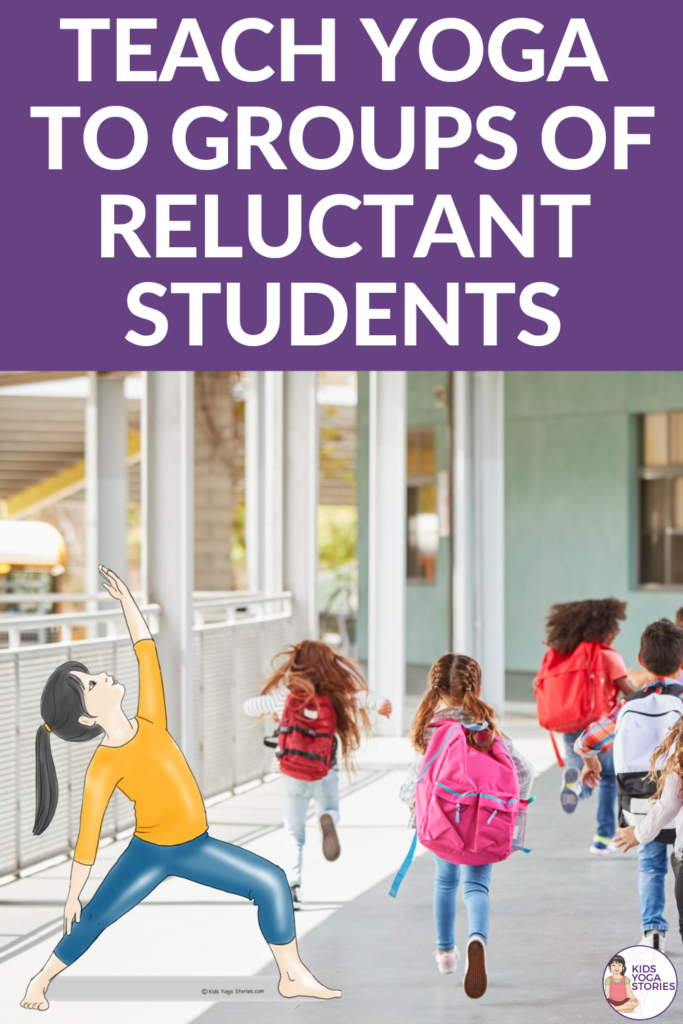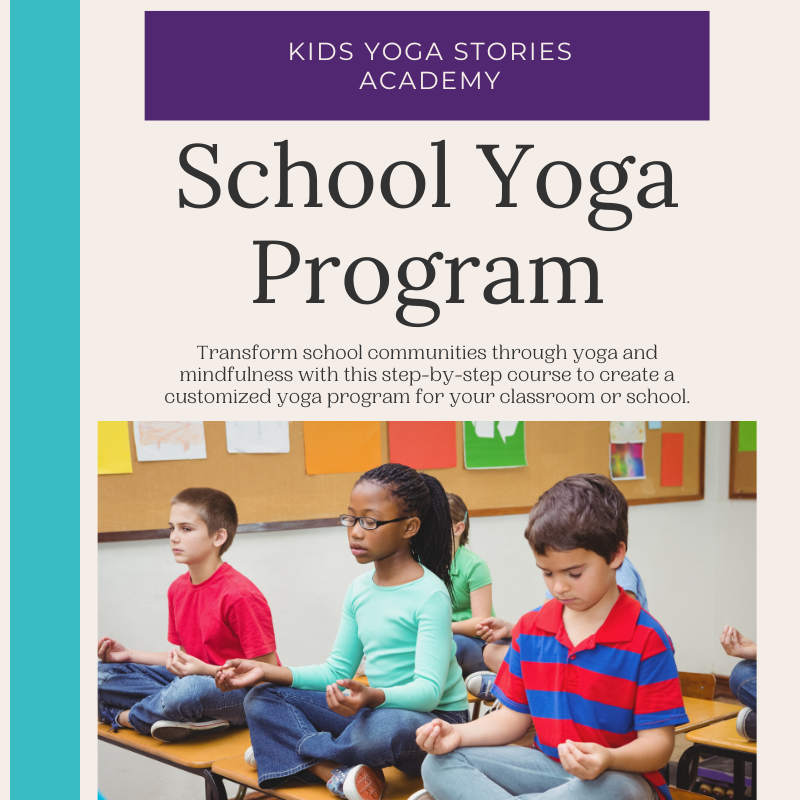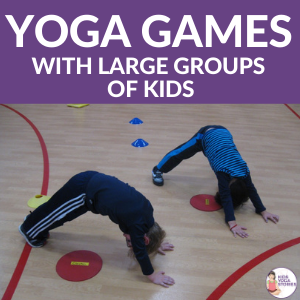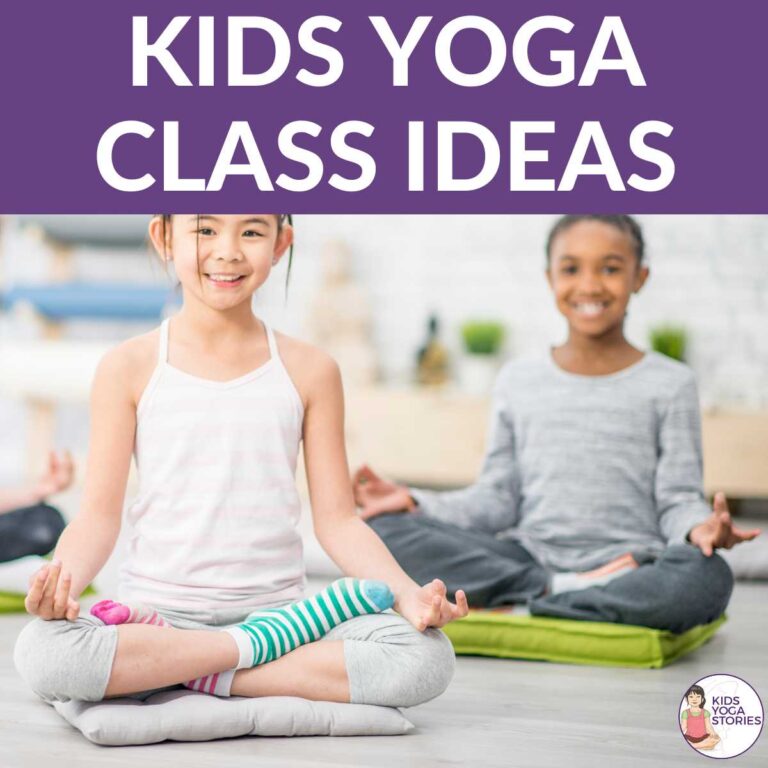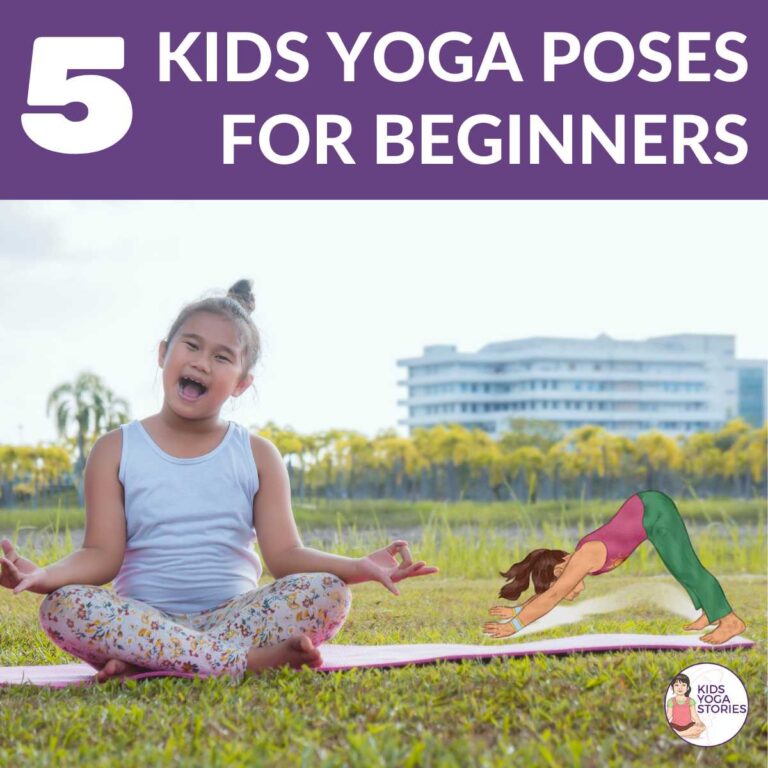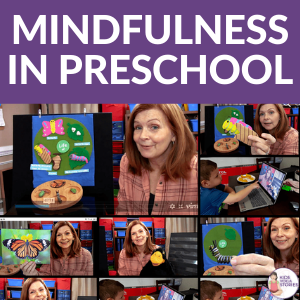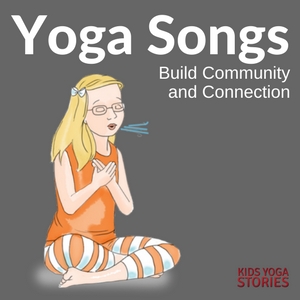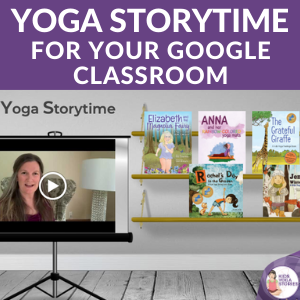How (and What) to Teach Yoga to a Large Group of Reluctant Students
In today’s article, Cassandra Troughton, a teaching assistant, shares her experience and tips to teach yoga to a large group of reluctant students. This question of how and what to teach came up repeatedly when we surveyed our Kids Yoga Stories community. We felt it was time to bring you more yoga for groups ideas.
It was like a dream…
I had just received my FIRST BIG opportunity to practice yoga and mindfulness with students—school-wide!
I had been trying so hard to get yoga and mindfulness in front of my students.
And now… the recess intramurals teacher offered me the opportunity to take on the program with my own spin on it.
I would be introducing “Mind-Fitness” to a large group of elementary students.
This was my chance! Wahoooo!
Sounds amazing, doesn’t it?
The thing is… my students who showed up on the very first day of Mind-Fitness had no clue what they’d signed up for.
When they showed up to the gym that day, they were not expecting a quiet and calm yoga and mindfulness practice.
They’d expected typical intramurals play. They expected team sports. They expected running, sweating, and screaming at the top of their lungs.
Boy, were they wrong…
You could imagine the groans I received from a very reluctant group of kids in the gym that day.
It was not a good start.
I thought to myself, “What am I to do?”
Can you relate?
How is it possible to teach a large group of kids who, quite frankly, don’t want to be there?
5 things to keep in mind when teaching a large group of reluctant students:
#1: CALM
Get Calm and Organized
Kids feed off your energy. So, first things first, remain calm. Even if you feel thrown off because, like me, your students did not react well, you can remain calm by expecting the unexpected!
Not all kids will be open to yoga at first. It’s normal… and completely okay! It takes time to get kids to buy into something new. Expect a little pushback from a large group of kids.
Expect interruptions and expect the group to go off topic every now and then—they are kids after all. Remember to relax and have fun. Go with the flow! When reluctant kids see you and others having fun, they are more willing to join in!
With my group of students, if I had the opportunity, I would have prepared them for it. I would have given them a fair warning. I would have explained why we were doing Mind-Fitness in the first place and what the benefits were.
We don’t always have that luxury, though—and, that’s okay. But prepare for a little noncompliance and remain calm anyway!
#2: CURIOUS
Get Curious About Your Students
Time to analyze! Ask yourself some important questions:
“Why are they reluctant to try yoga?”
“Could there be something else going on here?”
“Perhaps, problems at home? Lack of self-esteem?”
Maybe they are afraid of looking funny in front of their peers. Or maybe they just struggle to express themselves. Figure out the underlying issue and address it.
In my case, the students were caught off guard. They’d expected to play sports, but instead, were bombarded with yoga and mindfulness activities. They were reluctant because they were frustrated.
They didn’t care about yoga because it wasn’t what they were expecting. I addressed it by asking myself how to make Mind-Fitness more engaging and integrate their interests (sports, in this case).
These were essential questions to ask myself, especially for the male students in this group who struggled with focusing on anything but competition.
#3: CONNECTION
Spend Time Connecting
Spend time connecting with your students. Removing a student from the class for “not participating” is harmful. Instead, remind them that this is a safe space and that they are welcome here, even if they choose to sit and watch instead.
Oftentimes, kids just need to know that you will hold space for them in order for them to take part. Build trust!
What’s a fool-proof way to build trust?
Ask questions! Ask about their lives or if they need help with anything. Sometimes, that means simply asking if they are hungry, and getting them a snack if they are. Show them you care!
And know that things don’t change immediately. Some students may take a few classes (even weeks) to open up. That’s okay! Have patience. Progress can be slow, but don’t push them. Especially with our kiddos who come from traumatic backgrounds or have severe anxiety, progress can be even slower. The change in schedule may overwhelm them. Just be there for them when they are ready.
In a large group, these kids have different needs and different comfort levels. They will come around on their own time. With Mind-Fitness, I spent a whole lot of time connecting with kids for a few weeks before the participation grew. During those weeks, I spent more time getting kids healthy snacks, giving out hugs, and providing a listening ear than I did practicing yoga and mindfulness.
Once kids realized they were in a safe space, they opened up to me. They were more open to listening to my suggestions. Mind-Fitness grew from 15% participation to 100% participation in a few weeks!
#4: CREATIVE
Think Outside the Box and Get Creative!
This goes along hand-in-hand with Step 2! Once you’re able to get curious about your students—what their interests are, what motivates them, or what might be holding them back—you can effectively tailor your yoga plans to suit their needs.
Yoga, especially for kids who have never been introduced to it before, might seem boring or even silly. So how can you make it more fun for these kids? How can you address their needs and interests in your yoga class?
My students showed up to Mind-Fitness because they were hoping for competitive sports. They wanted to be a part of a team and work toward some sort of gold medal game. So I added a competitive element to my Mind-Fitness class! I set them up on teams. Teams received points for rotating through the Mind-Fitness circuits. I kept score of the points, and we updated the rankings on a bulletin board in the hallway.
Another way to get creative with yoga is to add some leadership elements to the activities you’re teaching. Kids thrive as leaders if they’re given the chance. My Mind-Fitness students had the opportunity to lead their team members through the circuits and help keep score.
I had a group of leaders who helped me update the scoreboard each day. They took such pride in doing so. All the sudden kiddos who had attention span difficulties and behaviour issues weren’t having these problems anymore.
Why? Because I was addressing their likes! There was no need for them to interrupt the class or get distracted, because they were having fun!
#5: COMMIT
Don’t Give Up!
Harness that patience and remember you are in this for the long haul! Miracles don’t happen overnight. Students don’t carry over these skills immediately.
It requires lots of practice and patience for it to become a part of their automatic actions. Remember, though, progress is progress, no matter how small. Sometimes, it’s hard to see because we can’t get inside our students’ heads. But even if we don’t notice progress right away, there is something happening inside them!
Do not get discouraged if you make some progress and then kids digress. This is normal! Progress is not always linear. Stay committed! Remember why you are doing this important work in the first place and let that be your guide.
Now, a big part of committing to this process is committing to more than the activities you’re teaching. It’s also committing to showing your students the benefits of a regular yoga practice! This is especially key with older students. They may not want to hear the benefits right away—this is why you connect and build trust first! But eventually, they will be ready to hear it.
Part of their reluctance may be because they don’t see what yoga will do for them. Commit to teaching them about how it will benefit them in life.
There were definite ups and downs in Mind-Fitness. Not every day was perfect, but I didn’t get discouraged. I didn’t give up. I was able to weave in some lessons on how Mind-Fitness would help them in school and in playing sports! It wasn’t necessarily my ideal Yoga and Mindfulness class—and definitely not what I had in mind to start—but it proved its worth!
Before I leave you, I want to remind you how important it is to keep up with your own yoga practice in order to more effectively bring that same demeanour to your students. I begin each morning with ten minutes of yoga. I needed this yoga practice to center myself, remain calm for my kiddos, and embrace whatever was to come that day. This yoga practice allows me to be the best possible role model for my students and to be a mirror for them. They are worth it!
What Experienced Kids Yoga Teachers Have to Say
To hear from our other kids yoga teacher colleagues (many of whom have created successful full-time yoga businesses teaching school yoga), we asked this question on social media:
What’s your #1 tip for teaching yoga and mindfulness to a large group of reluctant students?
My best tip is to keep the class moving and play fun games. Large groups can get rowdy, plus there are always kids who simply don’t want to be there or who are tired and would rather not participate. By incorporating mindfulness elements into yoga games, they will have fun without even realizing that they’re practicing yoga!
Robyn Parets
Pretzel Kids
Keep showing up and make connections. Take an interest in their lives. Taking time to just talk about their day, night, weekend. Today, I heard some of my middle schoolers play truth or dare. Hmmm… I’m wondering if there is a truth or dare yoga game out there? Also, on days where I feel like I’m talking to no one (crickets), I just keep going even though I feel silly—hoping something may stick. I had one class (middle school) where we started with pranayama, talked, then ended with pranayama. I tossed my lesson plan because it seemed talking was the thing that was needed.
Serrina Davis
Damara Yoga
Let them lead! I’ve found the best way to engage younger children and preteens is let them tell you what games they would like to play or get them involved by circle sharing. Honestly, on the days when they don’t want to engage, I’ve noticed that by allowing them each to share their favorite part of summer or ice cream flavor (anything simple) really flips their mood. Sometimes we all just want to feel heard.
Darcel Smith
The Yogi Brain
I find that from ages five and up, journaling and mindful coloring is always welcomed by the kids. Journaling and drawing about gratitude is always my go-to. Books for the littler ones with either poses through the story or a chat about feelings/moods in the book afterwards usually wrangles even the runners in the group.
Shana Barone Conza
Libra Wellness
Make it culturally relevant for them! Make sure they’re seeing people who look like them and who they look up to who practice yoga/mindfulness. Create a bulletin board of athletes/celebs they look up to. More importantly, bring the voices of those icons into the classroom.
Emily Fleming
Emily Fleming Yoga
I’ve been doing breathing exercises and yoga all year for morning meetings with a fifth-grade class and have a few kids sometimes ruining the vibe. Recently, I started adding visualizations during centering in, like imagination a feather, see the door to your house, notice a candle lighting a dark room, etc. This helps the fidgety, reluctant ones stay focused.
Un Jung Lee
Don’t. Don’t teach them mindfulness. Ask them about what matters to them. Mindfully listen. Model mindfulness.
Abby Wills
Shanti Generation
Yoga is enough. Help the kids fall in love with yoga. Keep it fast paced; kids don’t want to sit still. Be playful.
Ashley Fontes
Read and Yoga
Embody yoga and mindfulness. Practice yoga and mindfulness. Arrive early. Fill the energy of the room with yoga and mindfulness. Have a plan for students who are not connecting—not a punitive one, simply a gentle invitation to go to a different supervised safe space. Breathe. Be ready with more content than you need and be flexible about throwing out your plan.
Lori Bisser
www.loribisser.com
I enjoy teaching mindfulness by example, by being mindful. For me, that means: paying attention to my energy and demonstrating compassion and kindness and avoiding trying to teach everything in one class. I pick a few activities for the class and try not to rush to fit everything in. Each class starts with what I see. I look at each person in the class when I arrive and see the energy, and the class knows they are seen too. If I notice someone upset or doing something unusual, I will check in with them privately for options to support them if needed. It also means using props and a visual lesson plan, which I find very helpful so the class knows what is expected of them throughout the class. Many kids learn better when they see the lesson as they hear it.
Kathy Aruna Humphrys
www.youngyogamasters.com
If you have any other advice or thoughts on how to teach yoga to reluctant children, please don’t hesitate to reach out—we would love to hear your story!
CHECK OUT OUR SCHOOL YOGA PROGRAM
This program guides you to create the perfect classroom/school yoga program that fits you, your students, and your school.
You will walk away from this program with a plan in hand and resources to get started right away! PLUS, you’ll have access to support, a community of other like-minded professionals (through our private Facebook group), and resources to give you the confidence to deliver a thoughtfully crafted program to your school community.
This program is based on a strong foundation, which starts with YOU, yet flexible enough to meet students where they’re at and change over time, if needed.
Find out more about you can transform your own school community through yoga and mindfulness with this step-by-step course to create a customized school yoga program for your classroom or your school.
ABOUT THE AUTHOR

Cassandra Troughton (a.k.a. Miss T) is an educational assistant from Canada. She has worked with Edmonton Public Schools for over seven years, primarily in the special needs adaptability program (Gr. 1-6) and as the Health and Wellness lead at her school in Edmonton, Alberta. Her passions include health, wellness, and the practice of mindfulness! She loves passing on her knowledge of mindfulness to her students and fellow educators. You can find her at https://mindfulmisst.com/. She is currently the Community Coordinator of Kids Yoga Stories.
SAVE IT FOR LATER
